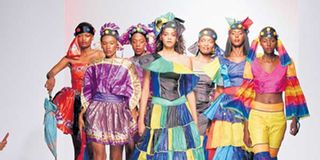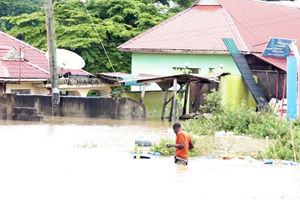Ten years of Swahili Fashion Week

Models hit the ramp at the end of Afrika Sana’s showcase at the Swahili Fashion Week 2017. PHOTO I SDR
What you need to know:
And as many an observer will say this has not been a mean feet by any standards for it has been years of hard work and dedication given the fact that it is the only one surviving in this part of Africa.
Dar es Salaam. The haute couture fraternity over the weekend descended on Dar es Salaam for the 10 edition of the increasingly popular Swahili Fashion Week 2017.
And as many an observer will say this has not been a mean feet by any standards for it has been years of hard work and dedication given the fact that it is the only one surviving in this part of Africa.
There was no better place to catch a glimpse of what is to come than at the launch at National Museum in Dar es Salaam, where the Cream de la creame converged.
As part of the diversity and growth, this year’s show featured emerging designers’ competition featuring finalists who were selected by an independent panel of judges.
These included Agnes Sixbeabeatus, Anjali Borkhataria, Charity Nyaimaga, Edina Emmanuel, Emmanuel Kisusi, Gisela Kaguo, Jackline Ottaru, Liberatha Alibalio, Mary Immaculate Gervace, and Mohammed Juma.
And for the first time the contest was shared as Emmanuel Kisusi and Maryimmaculate Gervace emerged winners replacing last year’s Shahbaz Sayed.
Featuring over 30 local and 13 international established designers the whole place was abuzz with activity, as models graced the catwalk to showcase some of the collections on offer.
In the name diversity again, plus size women too were celebrated for the first time in an industry that has in the past drawn criticism for its inclination for the size zero models.
Mustafa’s resume has grown with time from attending fashion galas to hosting one in his native country and from the kind of association he had in the just concluded gala, he is with the best.
For the three days as designers, models, fashionistas and socialites sampled the designs on offer, one thing that sticks out is the fact that the show has grown to gain a rare international recognition.
Behind what you see on the stage there is a lot of hard work and time invested and it is not for the faint hearted.
As the men and women with fine taste from the A-list converged in Dar es Salaam, some have been wondering how the idea of this epic fashion extravaganza was ever conceived.
The Swahili Fashion Week, Mustafa Hassanali’s brainchild was conceived from a friend’s advice while staging an exhibition in Mozambique. “Given the experience I had gained from the different exhibitions that I had attended, I thought it was about time to create a platform through which we could celebrate our own designs,” says Mustafa.
But the idea did not crystalise immediately.
“At first I thought about creating an East African thing, I realised that Swahili would have a broad coverage than just East Africa,” Mustafa told the Beat in an interview.
It is for that reason that during the week Mustafa himself does not exhibit his creations and instead gives the opportunity to other designers from the Swahili speaking countries. “It was not about me, there was a need to come together and collectively promote the buzz about what is ours,” he once told the Citizen.
However, as Mustafa had the grand vision of creating a platform for designers, a crude reality was waiting in the wings.
There was basically no support for his new born project and he had to grapple with funding given the fact that even attendance for the show was quite low.
From very humble beginnings struggling with sponsorship, 10 years down the road the extravaganza has grown with fondness in many hearts and it has become the reference point of fashion in this part of the continent.
The number of designers who sign to show case at this gala is testimony of how fast the event has grown in stature.
Apart from the designers, the exhibition also attracts models who travel from different countries to come for the casting.
To these women it is a platform for major things that lie in the waiting, for it doesn’t come any bigger than this!
When Mustafa Hassanali came up with Swahili Fashion Week in 2007 it was more of a wild goose chase, but 10 years down the road may be it is time to take stock.
For example in 2012 of the 50 designers who showcased their collections, 15 were international, 22 were ‘established’ Tanzanian designers and 12 were up and coming.
Together with other shows such as the Red Ribbon, Lady in Red, Kanga Ya Kale, Harusi Trade Fair and others such as Kidoti, point toward a vibrant industry- a lion waiting to pounce.
These shows have been very instrumental in not only showing the African creativity but also in unearthing young talents who are now ready to challenge the old guard.
Local fashion shows even scored a rare one in 2009 when Mustafa Hassanali hosted super model Naomi Campbell who is undoubtedly one of the greatest models to grace the catwalk on this planet.
“These, however small, are some of the signs that the industry is heading in the right direction. There are issues but these are things that have to be taken with one step at a time,” says one fashion writer.
Well it is at this stage that the serious question pops out whether the industry has finally come of age.
As one pundit puts it; if the number of shows in recent years is anything to go by then probably the answer should be in the affirmative.
In the earlier days local fashion exhibitions were more of entertainment events where most of the patrons were more attracted to the models than the collections.
However, this trend seems to have gradually changed with more of the extravaganzas featuring a local audience that are proud of the Made in Tanzania brand.




